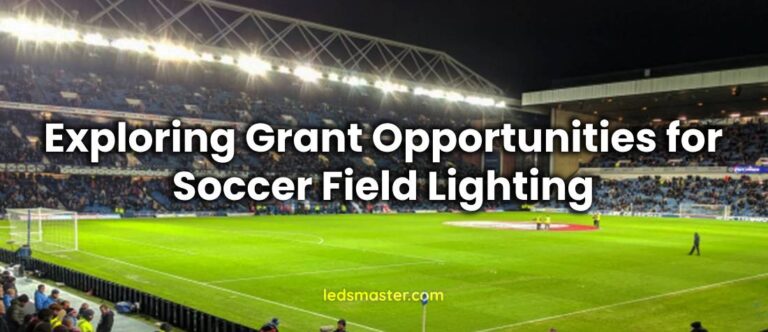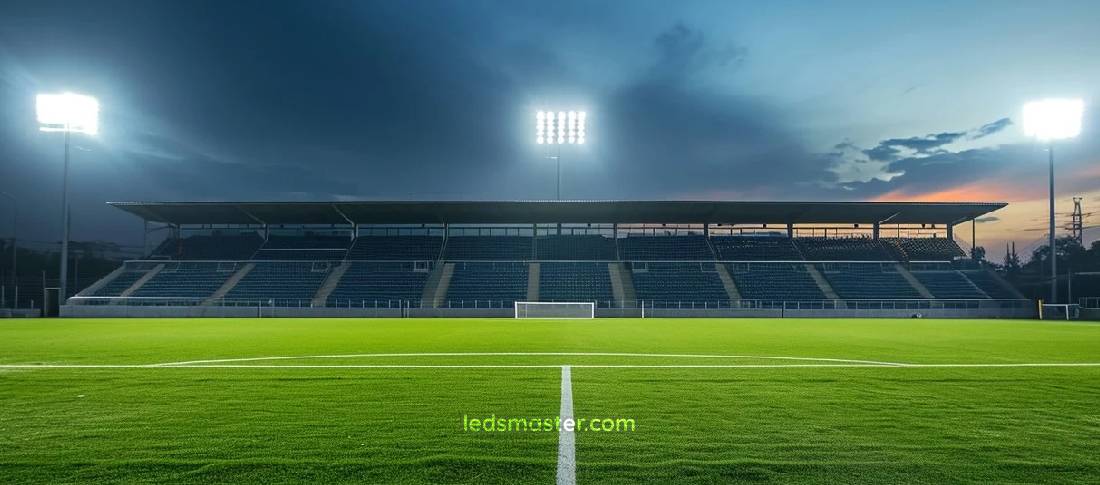
Experience the difference with modern LED lights that provide bright, consistent illumination while significantly reducing energy costs. Designed for durability, they keep your field ready for action in any weather, day or night.
Get your complimentary lighting design today
Our energy-efficient LED fixtures and expert installation ensure optimal lighting conditions, reducing operational costs while maintaining exceptional quality. Let us help you create the perfect playing environment with our cost-effective, durable, and innovative lighting solutions.
Soccer field lighting is essential for enabling safe and enjoyable gameplay, particularly during evening matches and training sessions. Beyond enhancing visibility for players and spectators, effective lighting minimizes injury risks and supports optimal performance in various weather conditions. Installing or upgrading soccer field lighting involves significant financial considerations, encompassing upfront costs of fixtures, installation expenses, ongoing operational and maintenance costs, and potential investments in advanced lighting control systems.
This article explores these cost factors comprehensively, providing insights to help stakeholders navigate the complexities of budgeting for soccer field lighting projects effectively.
Table of Contents
Toggle| Category | Subcategory | Estimated Cost Range (USD) |
|---|---|---|
| Lighting Fixtures | LED Fixtures | $50,000 – $150,000 |
| Metal Halide Fixtures | $40,000 – $120,000 | |
| Number of Fixtures | Varies based on field size | |
| Installation Costs | Labor | $15,000 – $40,000 |
| Electrical Work | $5,000 – $10,000 | |
| Operating Costs | Electricity | Variable based on usage |
| Maintenance Costs | Annual Maintenance | $1,000 – $5,000 per year |
| Long-term Warranty | Included in fixture cost | |
| Additional Costs | Site Preparation | $5,000 – $10,000 |
| Permits and Inspections | $2,000 – $5,000 | |
| Upgrading Costs | Lighting Control Systems | $10,000 – $30,000 |
One of the primary considerations in budgeting for soccer field lighting is the cost of lighting fixtures themselves. LED fixtures are increasingly popular due to their energy efficiency and long lifespan, albeit with a higher initial investment compared to traditional metal halide fixtures. LED fixtures for a standard soccer field can range from $50,000 to $150,000 USD, depending on the quality, brand, and number of fixtures required. Metal halide fixtures, while less expensive upfront, generally have higher operational costs due to greater energy consumption and shorter lifespans.

Installation costs are another significant aspect to budget for when planning soccer field lighting. These costs encompass labor charges for installation, electrical work required to connect the fixtures to power sources, and potentially additional expenses for equipment and materials. Factors influencing installation costs include the size and layout of the field, accessibility of the site, and local labor rates. On average, installation costs can range from $20,000 to $50,000 USD, with variations depending on site-specific factors and any additional requirements such as trenching for underground cables.
The complexity of the installation process can also impact costs. For instance, fields located in remote areas or those requiring extensive groundwork may incur higher expenses due to logistical challenges and the need for specialized equipment. Proper planning and coordination between contractors and electrical engineers are crucial to ensure that installations are carried out efficiently and in compliance with safety standards. Investing in experienced professionals and conducting thorough site assessments beforehand can help mitigate unexpected costs and delays, ensuring that the lighting system is installed effectively and meets the operational needs of the soccer field.
Operating costs are a critical consideration over the lifespan of the lighting system. The energy efficiency of the chosen fixtures directly impacts ongoing operational expenses, primarily through electricity consumption. LED lighting, known for its energy efficiency, consumes significantly less electricity than traditional metal halide lighting, resulting in lower monthly utility bills and reduced environmental impact. Estimating operating costs involves calculating the energy consumption based on fixture wattage and the number of hours the lights are in use each day.
Advancements in lighting technology continue to improve energy efficiency and operational savings. Some modern LED fixtures are equipped with smart controls and sensors that optimize light output based on real-time conditions such as natural light levels and occupancy. These features not only enhance energy efficiency but also extend the lifespan of the fixtures by reducing unnecessary usage. When evaluating lighting options, considering these innovative technologies can lead to substantial long-term savings and contribute to sustainability goals for sports facilities and community environments.
Maintenance costs are another ongoing consideration for soccer field lighting systems. While LED lights generally require less frequent maintenance compared to metal halide lights due to their longer lifespan and durability, budgeting for routine maintenance is still necessary. Typical maintenance tasks include periodic cleaning to maintain optimal light output, bulb replacements as needed, and inspections to ensure all components are functioning correctly. Annual maintenance costs typically range from $1,000 to $5,000 USD, depending on the size of the field and the complexity of the lighting system.
Proactive maintenance not only ensures consistent performance but also extends the lifespan of the lighting infrastructure. Engaging qualified technicians for regular inspections and servicing can identify potential issues early on, preventing costly repairs and downtime during critical events. Additionally, investing in fixtures with robust warranties and service agreements can provide peace of mind and minimize unexpected maintenance expenses over time. By prioritizing maintenance as part of the overall lifecycle management strategy, stakeholders can maximize the reliability and longevity of their soccer field lighting investment, ensuring uninterrupted play and safety for athletes and spectators alike.
Beyond the initial installation and operational expenses, there are additional costs to factor into the budget. These may include site preparation costs, such as clearing the area and preparing the foundation for lighting poles, as well as obtaining necessary permits and inspections from local authorities. These costs can vary widely depending on local regulations and the specifics of the installation site, adding approximately $5,000 to $10,000 USD to the overall project budget.
Investing in modern lighting control systems can enhance the functionality and efficiency of soccer field lighting. These systems allow for remote management, scheduling of lighting operations, and energy-saving features such as dimming during off-peak hours. While adding to the initial cost of the project, typically ranging from $10,000 to $30,000 USD depending on the complexity and features required, advanced lighting controls can result in significant long-term savings and operational efficiencies.
When seeking funding for soccer field lighting projects, there are several avenues to explore. Local governments, sports associations, and community organizations often provide grants or funding opportunities for community sports facilities. Additionally, sponsorship agreements with local businesses or fundraising campaigns within the community can help offset costs. Leveraging these funding sources requires thorough research, proposal preparation, and demonstrating the community benefits of improved lighting for sports and recreational activities.
Understanding the costs associated with soccer field lighting is essential for effectively planning and budgeting for such projects. By considering the initial investment in fixtures, installation costs, ongoing operating expenses, maintenance requirements, potential upgrades to lighting control systems, and additional project costs like site preparation and permits, stakeholders can make informed decisions that optimize both performance and long-term cost-effectiveness. Whether securing funding through grants, sponsorships, or community support, careful planning ensures that soccer fields are equipped with lighting systems that enhance safety, visibility, and overall enjoyment for players and spectators alike.